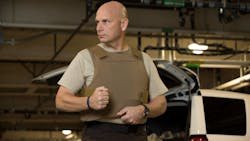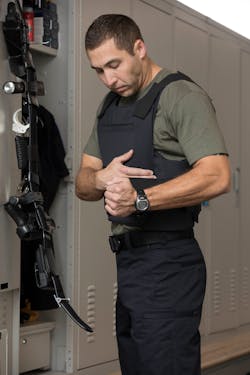Prepping Your Armor for Duty
Information provided by Propper International
Like every piece of duty gear, your body armor needs some attention before you throw it on at the start of your shift. If you’re diligent, you always check your weapon – so you know it’s functioning correctly and loaded with the right bullets – and be sure to have spare mags at the ready, tucked away in the pouches on your belt. Most LEOs are borderline OCD, which keeps them safe. Train for the unexpected by controlling what you can beforehand. You set up your duty rig the same way every day. In fact, you probably set it up once and have left it alone since then because everything is where you want it.
You always need a clean uniform, too, right? So you make sure the night before that tomorrow’s uniform is ready to go.
But what about your body armor? Do you check it on a regular basis? Have you adjusted it since the day you got it? Like most people, you’re probably not exactly the same size or shape you were the first day you strapped it on. Plus, thanks to changing seasons and everyday wear, your carrier has probably adjusted itself in ways you may not like. Does it fit the same way today? Probably not.
Let’s talk about how to properly set up new armor, adjust it, and then care for it.
Start with the Basics
This may sound silly, but you’d be surprised how many officers have their armor on backward. They didn’t notice that the front and back are cut differently. The front panel typically has a scoop at the top for your neck, while the back panel is often cut straight across for maximum protection. If you feel like your armor is choking you, check that it’s on the right way.
Speaking of direction, the ballistics inside the carrier is also designed to face (and, therefore, stop bullets) only one way. Hard plate armor is easy to figure out because it has an inflexible curve and might not even fit inside the carrier the wrong way, but soft armor is easy to get switched the wrong way. It, too, has unidirectional stopping power even though will fit into the carrier either way. The layers of threads and materials inside soft ballistics are designed to catch bullets facing one way only. Turn it with the back side facing forward and there is no guarantee it will work right. But this is an easy fix. Check your ballistic inserts to be sure the tag that says “This side faces body” is against you when you wear the vest. This may sound silly, but you would be amazed how often it happens – and it can mean the difference between life or death.
Adjustments
Most ballistic vests are alpha sized, meaning they come in a range of predetermined sizes just like clothes: S-XXL typically. Some vests – usually concealed carriers – are custom cut for the wearer because they need to fit smoothly under uniform shirts and provide maximum coverage and mobility for the individual officers. Whichever way your vest is sized, when you first get it and over the course of time it will need adjustment and readjustment. Straps stretch, material sags, your weight shifts, the cruiser seat rubs against it. All sorts of factors can lead to your armor not fitting exactly as it used to or as it should.
One common adjustment is the shoulder straps. Whether you wear a two-piece or four-piece carrier, the weight of the ballistics – especially with hard plates – will begin to slowly slide the shoulder straps down over time, so slow that you might not notice. Before you know it, the neck is too low and the top of the back doesn’t cover as high as it used to. Often, the best remedy is to just remove and adjust the straps. Sometimes, however, they will be too worn out or over stretched and need replacing. Luckily, straps are inexpensive.
To assure correct adjustment, put the vest on and either stand in front of a mirror or ask a reliable buddy to help you get it set up right. The vest should fit snuggly but not too tight and should cover vital organs. For four-piece vests, the cummerbunds need to hold the front and back panels firmly against your body. (If your vest is really out of shape or you have, ahem, changed shape since you got it, it might be time to get a new one.)
Cleaning and Maintenance
If you sweat, your armor stinks. It happens to all of us. However, you can’t just throw it in the wash. Armor is a specialized item, so it requires specialized care. But don’t worry – it’s not voodoo magic.
First, understand that the ballistics themselves cannot be cleaned the conventional way and should never be exposed to water. Wet ballistics threads loosen and cease to be effective protectors of life. That’s why they are sealed in waterproof protective sleeves from the factory. So long as the seal is intact, you can just wipe down the outside with a damp cloth to remove any grime. Do NOT use detergent or other harsh chemicals.
Second, while some manufacturers recommend machine-washing the carrier, most do not. Check the care instructions before throwing anything into the wash. You might not like the results. For those carriers that are not machine safe, clean them much the same way you clean the ballistics, with a damp cloth or sponge, and dry as soon as possible. This minimizes the time the material is exposed to water and maintains the fit of the fabric.
Conclusion
Proper prep and upkeep of your body armor can keep it looking good and working right for years.



